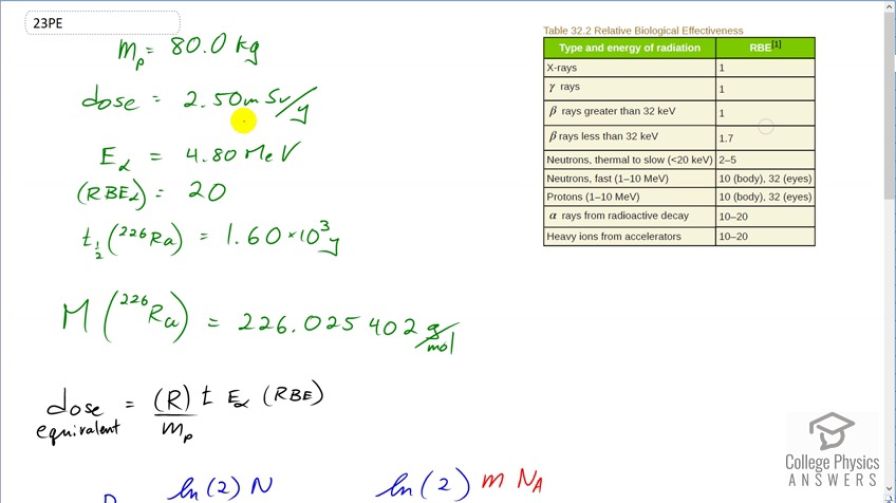Question
(a) Background radiation due to averages only 0.01 mSv/y, but it can range upward depending on where a person lives. Find the mass of in the 80.0-kg body of a man who receives a dose of 2.50-mSv/y from it, noting that each decay emits a 4.80-MeV particle. You may neglect dose due to daughters and assume a constant amount, evenly distributed due to balanced ingestion and bodily elimination. (b) Is it surprising that such a small mass could cause a measurable radiation dose? Explain.
Final Answer
- Yes, this mass is imperceptibly small. It has an outsized effect due to the relative biological effectiveness of the type of radiation, namely alpha particles.
Solution video
OpenStax College Physics for AP® Courses, Chapter 32, Problem 23 (Problems & Exercises)

vote with a rating of
votes with an average rating of
.
Calculator Screenshots
Video Transcript
This is College Physics Answers with Shaun Dychko. We are going to find the mass of radium-226 that a person has in their body if they are getting an exposure of 2.5 millisieverts per year from it. So the person has a mass of 80 kilograms and the energy per decay of radium-225 is 4.8 megaelectron volts and we need to know the relative biological effectiveness of alpha particles because that's the type of radiation coming from radium and the answer to that is 10 to 20 so let's take the worst case scenario and say it's 20. And the atomic mass of radium-226 is 226.025402 grams per mol which you look up in appendix A of the textbook. And that's all we need to know to figure out the mass of radium-226 that must be in the person's body. So the dose equivalent is the absorbed dose which is in joules per kilogram or grays in other words and you multiply that by the relative biological effectiveness of the type of radiation which is alpha rays; it has a RBE of 20. And this absorbed dose here is the activity multiplied by the time of the exposure and then multiplied by the energy per decay and divide by the mass of the person. Now the activity nowhere in here is the mass of radium-226 this mass is the mass of the person and so we are going to replace this activity R with an expression containing the mass of the radium-226. So activity is natural logarithm of 2 multiplied by the number of nuclei of radium-226 divided by the half-life and so then we can also replace the number of nuclei with the mass divided by the molar mass this gives the number of mols and multiply by Avogadro's number to turn the mols into number of nuclei. So we take all of this and replace R in our dose equivalent formula and I just write the word dose instead of dose equivalent because it's easier to write now. So we have the dose then is natural logarithm of 2 times the mass of the radium-226— maybe a subscript R there would be nice to remind us that's the mass of the radium— multiplied by Avogadro's number divided by the atomic mass times the half-life times the mass of the person that is not the mass of a proton, mass of a person there times by the duration of the exposure the energy per decay and then multiply by the RBE. So we need to solve this for mass of the radium and so multiply both sides by everything in the denominator and divide both sides by everything in the numerator except for the unknown that we are trying to solve for. and we end up with this line here that it is the dose times the atomic mass multiplied by the half-life multiplied by the mass of the person and divide by natural logarithm of 2 times the Avogadro's number times the duration of exposure times the energy per decay times the RBE and then we fill in numbers. So that's 2.5 millisieverts per year is the dose equivalent and multiply that by the number of grams per mol for radium-226 multiplied by the half-life of radium-226 which we have to look up in the appendix — 1.6 times 10 to the 3 years — and normally, we would convert units of years into seconds because seconds are an mks unit but we don't need to here since our dose equivalent is expressed in sieverts per year these year units will cancel. Then we multiply by 80 kilograms divide by natural logarithm of 2 times Avogadro's number times 1 year of exposure times the energy per decay in electron volts converted into joules and then multiply by the RBE of 20 giving us a mass of 11.3 nanograms of radium-226 to give 2.5 millisieverts per year dose equivalent to an 80 kilogram person.
